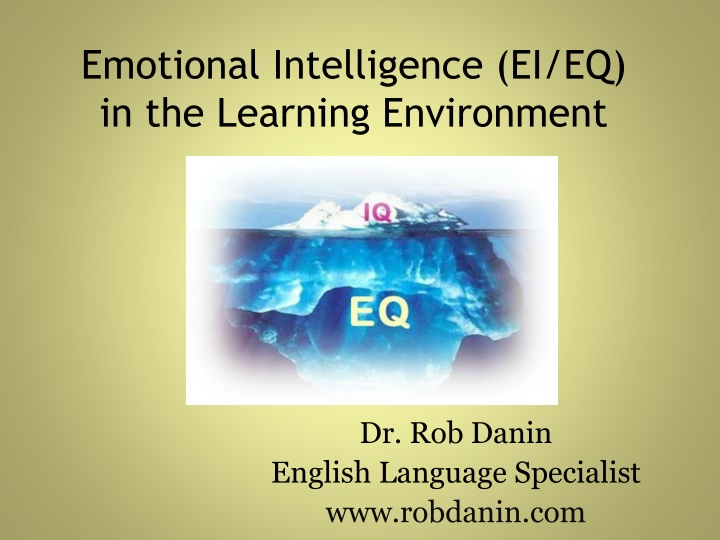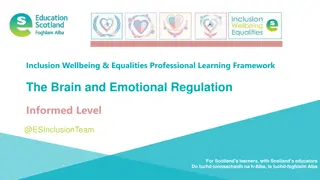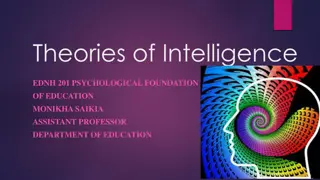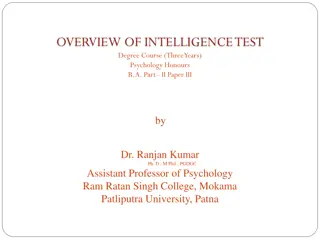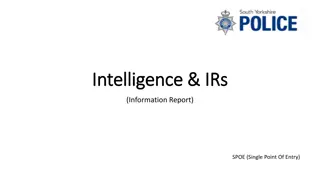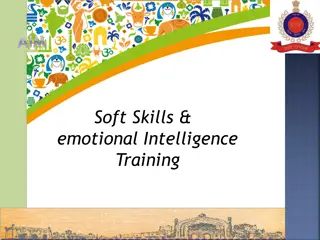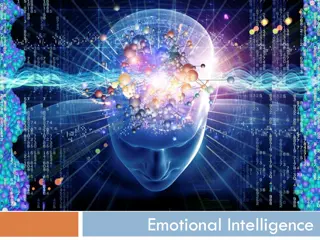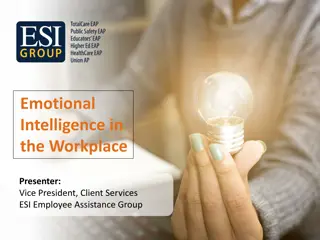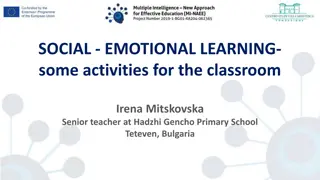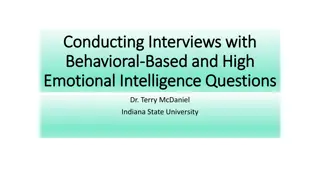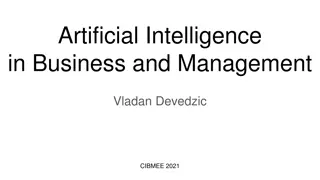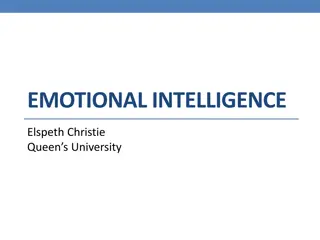Emotional Intelligence (EI/EQ) in the Learning Environment
Capacity for recognizing and managing emotions in ourselves and others, creating an environment that promotes emotional security, and enhancing motivation and self-awareness in learning.
Download Presentation

Please find below an Image/Link to download the presentation.
The content on the website is provided AS IS for your information and personal use only. It may not be sold, licensed, or shared on other websites without obtaining consent from the author.If you encounter any issues during the download, it is possible that the publisher has removed the file from their server.
You are allowed to download the files provided on this website for personal or commercial use, subject to the condition that they are used lawfully. All files are the property of their respective owners.
The content on the website is provided AS IS for your information and personal use only. It may not be sold, licensed, or shared on other websites without obtaining consent from the author.
E N D
Presentation Transcript
Emotional Intelligence (EI/EQ) in the Learning Environment Dr. Rob Danin English Language Specialist www.robdanin.com
Emotional Intelligence (EI) The capacity for recognizing our own feelings and those of others, for motivating ourselves, for managing emotions well in ourselves and in our relationships. (Goleman, 1995)
EI Definition A form of social intelligence that involves the ability to monitor one s own and others feelings and emotions, and to use this information to guide one s thinking and action. All learning has an emotional base. (Plato)
Emotional Intelligence (EI/EQ): Daniel Goleman (1995) Affective Education: Emotions and feelings of inadequacy tend to be stronger when students learn a foreign language. (Genesee, et al., 2006) Teachers need to create a learning environment that promotes emotional security Intelligent use of one s emotions Teachers set the emotional tone of the classroom Based on brain research: passion, motivation, commitment Self-directed learning The ability to be self-aware The ability to manage oneself Encourages motivation to develop one s abilities by celebrating one s strengths rather than focusing on weaknesses Provides an intrinsic motivation to learn
IQ EQ EQ is a more reliable predictor of academic achievement than is IQ. (Goleman, 1995)
What is Emotional Intelligence (EI)? EI is the ability to... perceive emotions by both teacher and student. understand complex emotions and emotional knowledge. access and generate emotions so as it assist thought. reflectively regulate emotions so as to promote emotional and intellectual growth. 1. 2. 3. 4.
Four Basic Components of EI Self - awareness Empathy Motivation Social Skills
Components of Emotional Intelligence Definition Attributes The ability to recognize and understand your moods and emotions well as their effects on others -- Self-confidence -- Realistic personal growth -- Comfort with ambiguity -- Openness to change -- Sense of humor Self Awareness A passion to work for reasons that go beyond money or status Strong drive to achieve Motivation Optimism, even in the face of failure The propensity to suspend judgment to think before acting The ability to understand the emotional makeup of other people Expertise in building ones learning abilities Empathy Skill in treating people according to their emotional reactions Cross-cultural sensitivity Proficiency in managing relationships Effectiveness in working with others Social Skills An ability to find common group & build rapport Developing influence and confidence by others
Education and EI Creates a relationship-centered [student- centered] approach to education Has the potential to be considerably more motivating for students Students cope better with transitions Lower drop out from secondary school and university Higher academic qualifications Better career prospects When students perceive that their teachers are competent and caring, then they are less likely to cheat in those classrooms.
How Can Teachers Use Emotional Intelligence? Pay attention to self and other s body language Listen more; speak less - develops empathy Get curious, not furious - Watch what you say especially when frustrated or annoyed. Reframe negative emotions can be replaced with, "Do you see something in this that I must have missed? Elicit pride in others Reason for working together Remember that emotions are contagious - A person's emotions (negative or positive) always influences others. Teachers should be careful to show only those emotions, which they want to see in others (The Golden Rule).
What educators can do to stimulate EI skills in their students CLEAR COMMUNICATION EMPATHY SELF AWARENESS DECISION MAKING PROBLEM SOLVING SHARING PATIENCE LISTENING CARING GETTING ALONG WITH OTHERS GENTLENESS PERSEVERANCE SELF MOTIVATION SELF CONTROL
EI = Social-Emotional Learning Social-emotional learning helps students build resiliency and learn from failure. It helps them make the best choices in life. Social-emotional Competencies are: Self-awareness - the ability to recognize one's own feelings, interests and strengths Self-management - skills allow individuals to handle daily stresses and control their emotions under difficult situations Social awareness - allows individuals to take other perspectives into account and to empathize with others Relationship Management - allows students to develop and maintain healthy relationships with others and seek help when needed Responsible decision making - enables students to keep in mind respect and safety concerns when making decisions
EI&EFL Emotional intelligence is a factor in second language learning. Enhance the integration of cognition with affect EI involves "knowing what one s feelings are and using that knowledge to make good decisions." (Goleman, 1995) This includes the ability to maintain hope and an optimistic outlook in the face of disappointments and difficulties [a common occurrence for many SLLs].
EI Educational Practices Student-Centered Discipline Responsibility and Choice Warmth and Support (Teacher and Peer) Cooperative Learning Classroom Discussions Self-Reflection and Self-Assessment Balanced [Varied] Instruction Realistic Academic Expectations Modeling, Practicing, Feedback, Coaching There are valuable lessons in failing . Mistakes can teach us that it is not that we are bad at something, just that we have to try a different method to find success. It teaches resilience .
EI Educational Techniques Ice breakers (to enable students to get to know each other) Warm ups/Sponge Activities (to generate interest in/review of the lesson) Providing varied learning activities (this maintains interest and also allows for different learning styles) Brainstorming and discussion - encourages the sharing of knowledge and opinions
EI Educational Techniques Role-playing and simulations that are related to the real world Promoting group/project work that encourages cooperation (e.g., Cooperative Learning) Providing feedback (use of continuous assessments to help determine students' academic progress in the subject area) Managing expectations (relates to giving feedback and making students aware of what is expected)
EI Educational Techniques Introduce journal writing. This familiar educational tool can be an effective way to help students develop self-awareness along with developing writing skills. Emphasize responsibility. Helps to encourage a sense of responsibility (e.g., organized classroom tasks). Encourage creativity. Creativity is most necessary in times of emotional hardship, such as when we're frustrated or angry. Provide students with ongoing opportunities to express their creativity. Institute classroom meetings. This can provide numerous opportunities to support social and emotional learning. It helps build a sense of community, creates a climate of trust, and encourages respectful communication. See next Responsive Classroom Methods slide
Emotional Intelligence (EQ/EI): Responsive Classroom Methods A Sense of Community The goal is to help create a culture where students care about each other, their school/classroom and their learning. Designed to improve the ways teachers interact with students and the way the students interact with each other. Classroom Meetings can be used to build classroom community Gets students ready for the lesson goals/objectives/outcomes Helps in providing calm and smooth classroom transitions Reinforces the proper use of social skills among the students Learn the students' names, ask about their lives outside of class, offer to help with assignments, offer more opportunities for student choice and voice in the classroom. Students' perceptions of their school can also affect cheating behavior. When students perceive feel like they belong in the school community they are less likely to cheat.
EI/EQ Quiz (Body Language) http://greatergood.berkeley.edu/ei_quiz/
How to Improve Our EI Observe how we react to people. Try to put ourself in their place, and be more open and accepting of their perspectives and needs. Do continuous self-evaluation. What are our weaknesses? Strengths? Examine how we react to stressful situations. Take responsibility for our actions. Examine how our actions will affect others. Would we want to experience those actions?
EI Classroom Survey Can be used to promote self-awareness and open communication
EI Can Be Developed at Any Age Age and maturity are positively correlated with EI Children develop emotional intelligence during the first 15 years of life as they mature. (Goleman, 1995) Emotional intelligence skills allows us to be more effective both professionally and personally.
EI/EQ Group Discussions Group 1 What approaches do you use to build a safe and caring learning environment? Group 2 What instructional strategies do you use to improve the learner s ability to express emotions appropriately. Make responsible decisions, and solve problems effectively? Group 3 How can you integrate social-emotional learning with traditional academics to enhance learning?
In Summary Emotional Intelligence is the ability to: recognize your emotions, understand what they're telling you, and realize how your emotions affect people around you. understand your perception of others: when you understand how they feel, this allows you to manage relationships more effectively.
In Closing 1. How would you like students to relate to one another within your classroom/behavior management system? 2.How much choice will you give students within your classroom/behavior management system? Top 10 Qualities of an Effective Teacher (2:33) https://www.youtube.com/watch?v=kQORgscVLcs
Enjoy having www.robdanin.com
